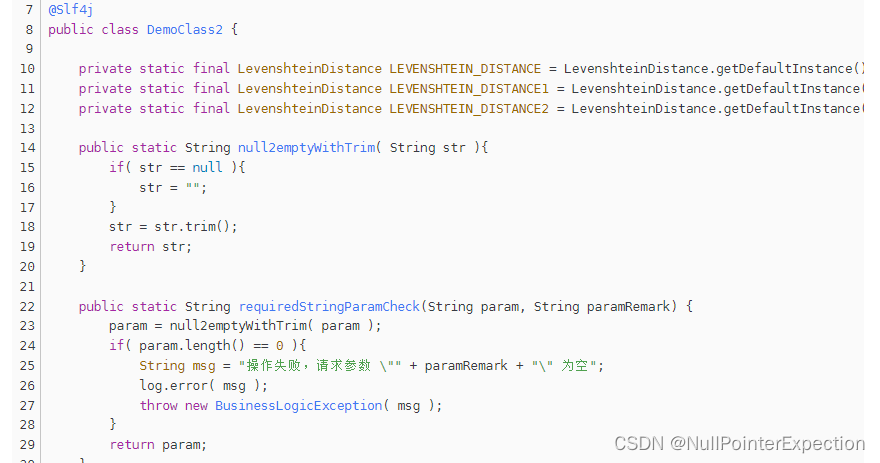
這是 git diff 后的效果,感覺挺簡單的,不就是 比較新舊版本,新增了就用 "+" 顯示新加一行,刪除了就用 "-" 顯示刪除一行,修改了一行就用 "-"、"+" 顯示將舊版本中的該行干掉了并且新版本中增加了一行,即使用 "刪除" + "新增" 操作代替 "修改" 操作,然后就用
然后我們寫的測試代碼如下:
import com.goldwind.ipark.common.util.MyStringUitls;
import org.apache.commons.text.similarity.LevenshteinDistance;import java.io.BufferedReader;
import java.io.FileReader;
import java.util.ArrayList;
import java.util.List;public class MyDiffTest {public static void main(String[] args) {List<String> lines_old = loadTxtFile2List("C:\\E\\javaCode\\git\\outer_project\\guodiantou\\gdtipark-user-servie\\src\\main\\java\\com\\goldwind\\ipark\\base\\test\\DemoClass1.java" );List<String> lines_new = loadTxtFile2List("C:\\E\\javaCode\\git\\outer_project\\guodiantou\\gdtipark-user-servie\\src\\main\\java\\com\\goldwind\\ipark\\base\\test\\DemoClass2.java");// lines1的起始行和 lines2 的起始行做映射// 掃描舊版本中的每一行int size = lines_old.size();for( int i=0;i<size;i++ ){// 從新版本中找該行String line_old = lines_old.get(i);String line_new = lines_new.get(i);// 如果發現版本中中該行的數據變了,那么提示刪除了舊的行,添加了新的行if( line_new.equals( line_old ) ){System.out.println( line_old );}else {System.out.println( "- " + line_old );System.out.println( "+ " + line_new );}}// xxxx xxxx1 -xxxx// yyyy yyyy +xxxx1// xxxxxx xxxxxx xxxxxx// zzzz zzzz zzzz}private static List<String> loadTxtFile2List(String filePath) {BufferedReader reader = null;List<String> lines = new ArrayList<>();try {reader = new BufferedReader(new FileReader(filePath));String line = reader.readLine();while (line != null) {// System.out.println(line);lines.add( line );line = reader.readLine();}return lines;} catch (Exception e) {e.printStackTrace();return null;} finally {if (reader != null) {try {reader.close();} catch (Exception e) {e.printStackTrace();}}}}
}其中用到的2個新舊版本的文本如下:
DemoClass1.java:
import com.goldwind.ipark.common.exception.BusinessLogicException;
import lombok.extern.slf4j.Slf4j;
import org.apache.commons.text.similarity.LevenshteinDistance;@Slf4j
public class DemoClass1 {private static final LevenshteinDistance LEVENSHTEIN_DISTANCE = LevenshteinDistance.getDefaultInstance();public static String null2emptyWithTrim( String str ){if( str == null ){str = "";}str = str.trim();return str;}public static String requiredStringParamCheck(String param, String paramRemark) {param = null2emptyWithTrim( param );if( param.length() == 0 ){String msg = "操作失敗,請求參數 \"" + paramRemark + "\" 為空";log.error( msg );throw new BusinessLogicException( msg );}return param;}public static double calculateSimilarity( String str1,String str2 ){int distance = LEVENSHTEIN_DISTANCE.apply(str1, str2);double similarity = 1 - (double) distance / Math.max(str1.length(), str2.length());System.out.println("相似度:" + similarity);return similarity;}
}DemoClass2.java:
import com.goldwind.ipark.common.exception.BusinessLogicException;
import lombok.extern.slf4j.Slf4j;
import org.apache.commons.text.similarity.LevenshteinDistance;@Slf4j
public class DemoClass2 {private static final LevenshteinDistance LEVENSHTEIN_DISTANCE = LevenshteinDistance.getDefaultInstance();private static final LevenshteinDistance LEVENSHTEIN_DISTANCE1 = LevenshteinDistance.getDefaultInstance();private static final LevenshteinDistance LEVENSHTEIN_DISTANCE2 = LevenshteinDistance.getDefaultInstance();public static String null2emptyWithTrim( String str ){if( str == null ){str = "";}str = str.trim();return str;}public static String requiredStringParamCheck(String param, String paramRemark) {param = null2emptyWithTrim( param );if( param.length() == 0 ){String msg = "操作失敗,請求參數 \"" + paramRemark + "\" 為空";log.error( msg );throw new BusinessLogicException( msg );}return param;}public static double calculateSimilarity( String str1,String str2 ){int distance = LEVENSHTEIN_DISTANCE.apply(str1, str2);double similarity = 1 - (double) distance / Math.max(str1.length(), str2.length());System.out.println("相似度:" + similarity);return similarity;}
}DemoClass2.java 相較于 DemoClass1.java 的區別是 "public class" 后面的類名不同,"private static final LevenshteinDistance LEVENSHTEIN_DISTANC..." 多復制了2行并改了名稱,然后運行后顯示差別如下:
import com.goldwind.ipark.common.exception.BusinessLogicException;
import lombok.extern.slf4j.Slf4j;
import org.apache.commons.text.similarity.LevenshteinDistance;@Slf4j
- public class DemoClass1 {
+ public class DemoClass2 {private static final LevenshteinDistance LEVENSHTEIN_DISTANCE = LevenshteinDistance.getDefaultInstance();
-
+ private static final LevenshteinDistance LEVENSHTEIN_DISTANCE1 = LevenshteinDistance.getDefaultInstance();
- public static String null2emptyWithTrim( String str ){
+ private static final LevenshteinDistance LEVENSHTEIN_DISTANCE2 = LevenshteinDistance.getDefaultInstance();
- if( str == null ){
+
- str = "";
+ public static String null2emptyWithTrim( String str ){
- }
+ if( str == null ){
- str = str.trim();
+ str = "";
- return str;
+ }
- }
+ str = str.trim();
-
+ return str;
- public static String requiredStringParamCheck(String param, String paramRemark) {
+ }
- param = null2emptyWithTrim( param );
+
- if( param.length() == 0 ){
+ public static String requiredStringParamCheck(String param, String paramRemark) {
- String msg = "操作失敗,請求參數 \"" + paramRemark + "\" 為空";
+ param = null2emptyWithTrim( param );
- log.error( msg );
+ if( param.length() == 0 ){
- throw new BusinessLogicException( msg );
+ String msg = "操作失敗,請求參數 \"" + paramRemark + "\" 為空";
- }
+ log.error( msg );
- return param;
+ throw new BusinessLogicException( msg );
- }
+ }
-
+ return param;
- public static double calculateSimilarity( String str1,String str2 ){
+ }
- int distance = LEVENSHTEIN_DISTANCE.apply(str1, str2);
+
- double similarity = 1 - (double) distance / Math.max(str1.length(), str2.length());
+ public static double calculateSimilarity( String str1,String str2 ){
- System.out.println("相似度:" + similarity);
+ int distance = LEVENSHTEIN_DISTANCE.apply(str1, str2);
- return similarity;
+ double similarity = 1 - (double) distance / Math.max(str1.length(), str2.length());
- }
+ System.out.println("相似度:" + similarity);
- }
+ return similarity;為啥???


如上兩張圖片,舊版本的第10行和新版本的第10行對應,從直觀上看新版本的第11、12行是在舊版本的第10行和第11行之間插進去的,但是程序并不這么認為,它會認為將舊版本的第11行的空白行修改為了新版本的 “private static final LevenshteinDistance LEVENSHTEIN_DISTANCE1 = LevenshteinDistance.getDefaultInstance();” 為什么我們人眼會這么直觀的感覺到 新版本的 第11、12行時插進去的,因為我們比較了新舊版本的第7、8、9、10行都差不多,舊版本的11~27行和新版本的 13~29行都差不多,所以自然而然的認為新版本的11、12行是直接插進去的,那么現在我們就來算法實現吧!( ps:前文中的 “差不多” 是差幾多?是完全equals 還是很像?”其實這里可以設置一個閾值,使用求字符串的相似度算法求出相似度,網上有現成的類庫求相似度,自己也可以使用動態規劃寫一個簡單的字符串相似度算法?)
感覺恰當的算法的執行過程應該是這樣的:
新舊版本各維持一個行號游標:index_old、index_new,最開始這兩個游標相同,越往后可能不同,但是他們表示的行的內容應該是應該相似的,因為新版本的修改會導致內容越來越 “錯位”。假設我們從上面2張圖片的第7行開始描:
? ? ? ? 1. 最開始?index_old =?index_new = 7,算法檢測到新舊版本的第7行的內容相同( 后面我們就盡量用偽代碼表示,就不說這么多啰里啰嗦的話了?),即 lines_old[?7] = lines_new[?7]。
? ? ? ? 2.?index_old++,index_new++,都變為8,算法檢測到 lines_old[ 8 ] != lines_new[?index_new ],并且他們的相似度很高,所以算法判斷新版本的第8行相較于舊版本的第8行是做了修改操作。
? ? ? ? 3.?index_old++,index_new++,都變為9,算法檢測到 lines_old[ 9?] = lines_new[ 9 ]。
? ? ? ? 4.?index_old++,index_new++,都變為10,算法檢測到 lines_old[ 10?] = lines_new[ 10?]。
? ? ? ? 5.??index_old++,index_new++,都變為11,算法檢測到 lines_old[ 11?] !=??lines_new[ 11?],并且這兩行的文本內容及不相似,所以判斷新版本是在舊版本的第11行插入了一行 “private static final LevenshteinDistance LEVENSHTEIN_DISTANCE1 =LevenshteinDistance.getDefaultInstance();”,所以此時舊版本的第11行就和新版本的第11行對應不上了,而是和新版本的第12行做對應。
? ? ? ? 6.??index_old 不變,index_new++,index_old 還是11,index_new 變為 12,即舊版本的第11行要和新版本的第12行做對應,就像找老婆一樣,舊7和新7結為了夫妻,舊8和新8結為了夫妻( 雖然有一點點的裂痕,但不打緊?),新9和新9結為了夫妻,...,所以舊11也要在新版本中找到一個新x作為自己的伴侶,本來已經找到了一個新11,但是發現新11和自己三觀差別很大,根本合不來,所以pass掉,繼續找,現在發現了下一個相親對象 新12,發現lines_old[ 11 ] 和 lines_new[ 12 ] 相似度還是差別很大,所以算法判斷新版本又插入了一個新行 “private static final LevenshteinDistance LEVENSHTEIN_DISTANCE2 = LevenshteinDistance.getDefaultInstance();”。
? ? ? ? 7.?index_old 不變,index_new++,index_old 還是11,index_new 變為 13,因為?lines_old[ 11 ] =?lines_new[ 13?],所以 舊11 很幸運的找到了自己的伴侶 新13,。
? ? ? ? 8.??index_old++,index_new++,index_old變為12,index_new變為14,因為?lines_old[ 12?] =?lines_new[ 14?],所以此步未檢測到變化。
? ? ? ? ...
改進后的測試代碼如下:
todo







)









)
)